Daily Milk Losses Associated with Dairy Cow Bunching, Cattle’s Protective Behavior Against Stable Flies (Stomoxys calcitrans) in California
Simple Summary
Abstract
1. Introduction
2. Materials and Methods
2.1. Modeling Milk Production Loss Associated with Cow Bunching and Stable Fly Biting the Current Study Was Approved on 25 February 2016 by the Institutional Animal Care and Use Committee, University of California, Davis (Protocol Number 19088)
2.1.1. Study Design
2.1.2. Milk Data
2.1.3. Statistical Analyses
Modeling Milk Production Loss
2.2. Economic Models for Estimating Milk Loss Due to Stable Fly Activity Across Five California Counties
2.2.1. Model Inputs
- Milk Data.
- 2.
- Regional Weather Data.
- 3.
- Stable Fly Activity and Associated Cow Bunching.
2.2.2. Economic Model
- Economic impact of bunching on milk production.
- Economic impact of stable fly activity on milk production.
- 2.
- Estimated Days at Peak and Days in Milk during the Bunching Season.
3. Results
3.1. Milk Loss Associated with Cow Bunching and Stable Fly Activity on a California Dairy
3.1.1. Descriptive Statistics
3.1.2. Association Between Cow Bunching and Milk Production
3.1.3. Association Between Stable Fly Activity and Milk Production
3.2. Results of the Simulation Model for the Economic Impact of Cow Bunching and Stable Fly on Milk Production for Five California Counties
3.2.1. Incidence of Cow Bunching
3.2.2. Stable Fly Activity
3.2.3. Milk Losses Due to Bunching
3.2.4. Economic Losses Due to Bunching
3.2.5. Milk Losses Due to Stable Fly Activity
3.2.6. Economic Losses Due to Stable Flies
4. Discussion
4.1. The Economic Impact of Cow Bunching on Milk Production
4.2. The Economic Impact of Stable Flies on Milk Production
4.3. Limitations
5. Conclusions
Author Contributions
Funding
Institutional Review Board Statement
Informed Consent Statement
Data Availability Statement
Acknowledgments
Conflicts of Interest
References
- Vitela-Mendoza, I.; Cruz-Vazquez, C.; Solano-Vergara, J.; Orihuela-Trujillo, A. Short communication: Relationship between serum cortisol concentration and defensive behavioral responses of dairy cows exposed to natural infestation by stable fly, Stomoxys calcitrans. J. Dairy Sci. 2016, 99, 9912–9916. [Google Scholar] [CrossRef] [PubMed]
- Mullens, B.A.; Lii, K.S.; Mao, Y.; Meyer, J.A.; Peterson, N.G.; Szijj, C.E. Behavioural responses of dairy cattle to the stable fly, Stomoxys calcitrans, in an open field environment. Med. Vet. Entomol. 2006, 20, 122–137. [Google Scholar] [CrossRef] [PubMed]
- Gerry, A.C.; Peterson, N.G.; Mullens, B.A. Predicting and Controlling Stable Flies on California Dairies; Contract No.: 8258; Regents of the University of California Division of Agriculture and Natural Resources: Oakland, CA, USA, 2007. [Google Scholar]
- El Ashmawy, W.R.; Williams, D.R.; Gerry, A.C.; Champagne, J.D.; Lehenbauer, T.W.; Aly, S.S. Risk factors affecting dairy cattle protective grouping behavior, commonly known as bunching, against Stomoxys calcitrans (L.) on California dairies. PLoS ONE 2019, 14, e0224987. [Google Scholar] [CrossRef] [PubMed] [PubMed Central]
- Wieman, G.A.; Campbell, J.B.; Deshazer, J.A.; Berry, I.L. Effects of stable flies (Diptera: Muscidae) and heat stress on weight gain and feed efficiency of feeder cattle. J. Econ. Entomol. 1992, 85, 1835–1842. [Google Scholar] [CrossRef] [PubMed]
- Mooring, M.S.; Hart, B.L. Animal Grouping for Protection from Parasites: Selfish Herd and Encounter-Dilution Effects. Behaviour 1992, 123, 173–193. [Google Scholar] [CrossRef]
- Hart, B.L. Behavioral adaptations to pathogens and parasites: Five strategies. Neurosci. Biobehav. Rev. 1990, 14, 273–294. [Google Scholar] [CrossRef] [PubMed]
- Taylor, D.B.; Friesen, K.; Zhu, J. Precipitation and Temperature Effects on Stable Fly (Diptera: Muscidae) Population Dynamics. Environ. Entomol. 2017, 46, 434–439. [Google Scholar] [CrossRef] [PubMed]
- Lysyk, T.J. Relationships Between Temperature and Life-History Parameters of Stomoxys calcitrans (Diptera: Muscidae). J. Med. Entomol. 1998, 35, 107–119. [Google Scholar] [CrossRef]
- Gilles, J.; David, J.-F.; Duvallet, G. Effects of Temperature on the Rate of Increase of Stomoxys calcitrans and Stomoxys niger niger (Diptera: Muscidae) from La Réunion Island. J. Med. Entomol. 2005, 42, 959–965. [Google Scholar] [CrossRef]
- Mullens, B.A.; Peterson, N.G. Relationship between rainfall and stable fly (Diptera: Muscidae) abundance on California dairies. J. Med. Entomol. 2005, 42, 705–708. [Google Scholar] [CrossRef] [PubMed]
- Rochon, K.; Hogsette, J.A.; Kaufman, P.E.; Olafson, P.U.; Swiger, S.L.; Taylor, D.B. Stable Fly (Diptera: Muscidae)—Biology, Management, and Research Needs. J. Integr. Pest. Manag. 2021, 12, 38. [Google Scholar] [CrossRef]
- Berry, L.; Stage, D.A.; Campbell, J.B. Populations and economic impacts of stable flies on cattle. Trans. ASAE 1983, 26, 873–877. [Google Scholar] [CrossRef]
- Freeborn, S.B.; Regan, M.; Folger, A.H. The relationship of flies and fly sprays to milk production. J. Econ. Entomol. 1928, 21, 494–501. [Google Scholar] [CrossRef]
- Bruce, W.N.; Decker, G.C. The Relationship of Stable Fly Abundance to Milk Production in Dairy Cattle. J. Econ. Entomol. 1958, 51, 269–274. [Google Scholar] [CrossRef]
- Taylor, D.B.; Moon, R.D.; Mark, D.R. Economic impact of stable flies (Diptera: Muscidae) on dairy and beef cattle production. J. Med. Entomol. 2012, 49, 198–209. [Google Scholar] [CrossRef] [PubMed]
- ElAshmawy, W.R.; Abdelfattah, E.M.; Williams, D.R.; Gerry, A.C.; Rossow, H.A.; Lehenbauer, T.W.; Aly, S.S. Stable fly activity is associated with dairy management practices and seasonal weather conditions. PLoS ONE 2021, 16, e0253946. [Google Scholar] [CrossRef] [PubMed] [PubMed Central]
- Aly, S.S.; Anderson, R.J.; Adaska, J.M.; Jiang, J.; Gardner, I.A. Association between Mycobacterium avium subspecies paratuberculosis infection and milk production in two California dairies. J. Dairy Sci. 2010, 93, 1030–1040. [Google Scholar] [CrossRef]
- Ferreira, F.C.; Gennari, R.S.; Dahl, G.E.; De Vries, A. Economic feasibility of cooling dry cows across the United States. J. Dairy Sci. 2016, 99, 9931–9941. [Google Scholar] [CrossRef]
- Zimbelman, R.; Rhoads, R.; Rhoads, M.; Duff, G.; Baumgard, L.; Collier, R. (Eds.) A re-evaluation of the impact of temperature humidity index (THI) and black globe humidity index (BGHI) on milk production in high producing dairy cows. In Proceedings of the Southwest Nutrition Conference, San Diego, CA, USA, 23–25 September 2009; USDA Cooperative State Research, Education, and Extension Service (CSREES): Tucson, AZ, USA, 2009. [Google Scholar]
- Warnes, M.L.; Finlyson, L.H. Effect of host behavior on host prefernce in Stomoxyes calcitrans. Med. Vet. Entomol. 1987, 1, 53–57. [Google Scholar] [CrossRef]
- Miller, R.W.; Pickens, L.G.; Morgan, N.O.; Thimijan, R.W.; Wilson, R.L. Effect of stable flies on feed intake and milk production of dairy cows. J. Econ. Entomol. 1973, 66, 711–713. [Google Scholar] [CrossRef]
- Cook, D. A Historical Review of Management Options Used against the Stable Fly (Diptera: Muscidae). Insects 2020, 11, 313. [Google Scholar] [CrossRef] [PubMed] [PubMed Central]
- Mullens, B.A.; Meyer, J.A. Seasonal abundance of stable flies (Diptera: Muscidae) on California dairies. J. Econ. Entomol. 1987, 80, 1039–1043. [Google Scholar] [CrossRef] [PubMed]
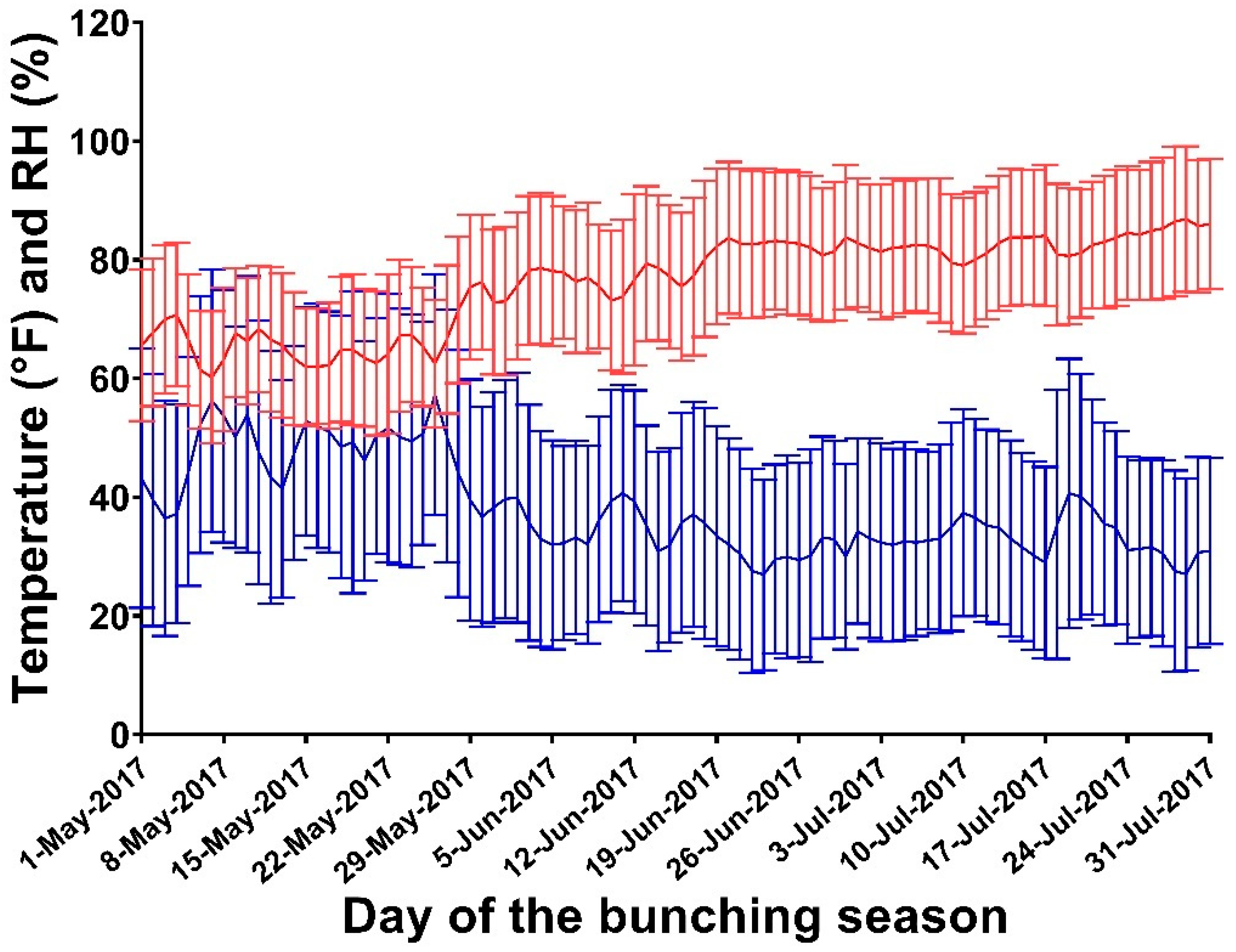
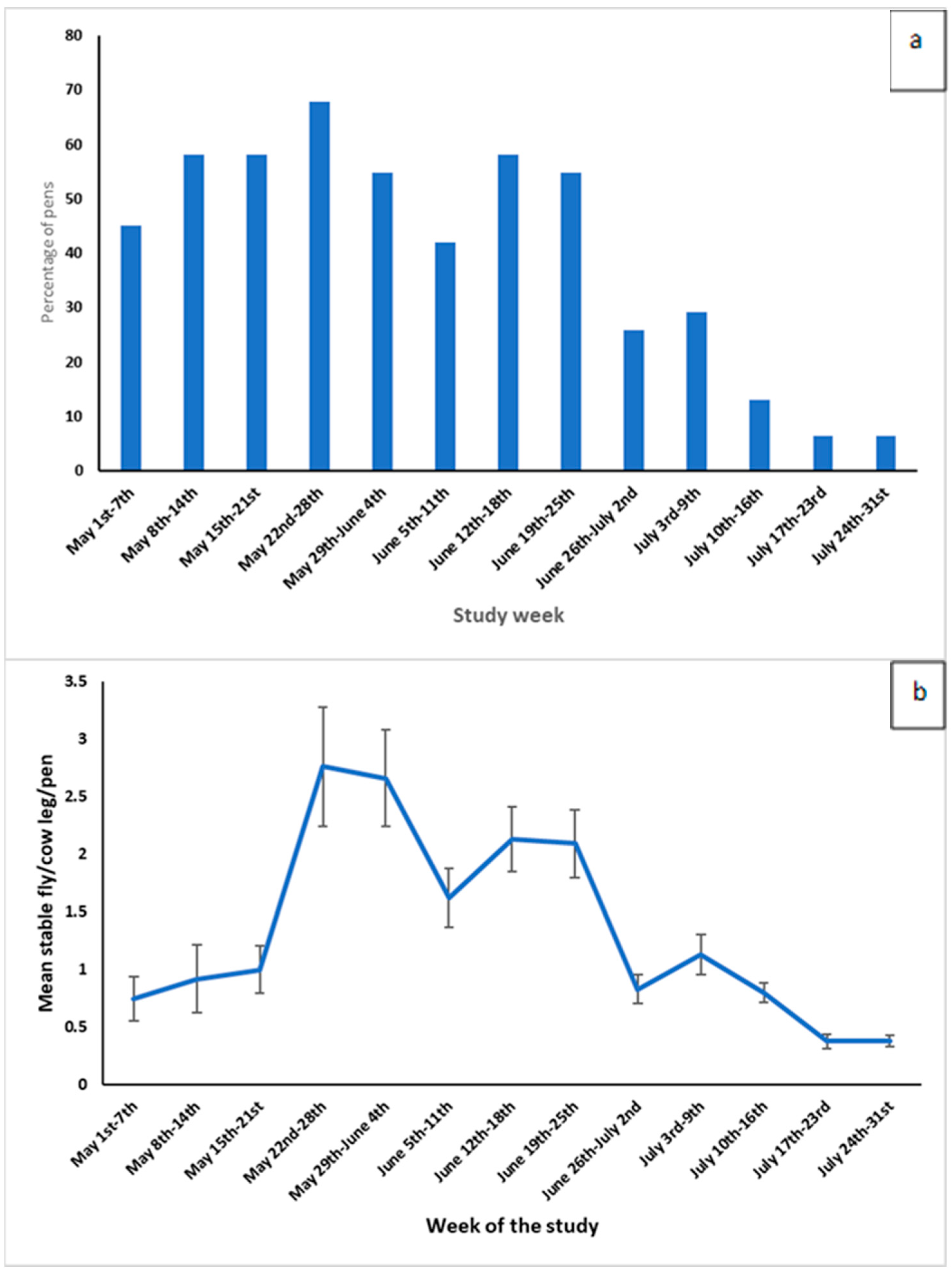
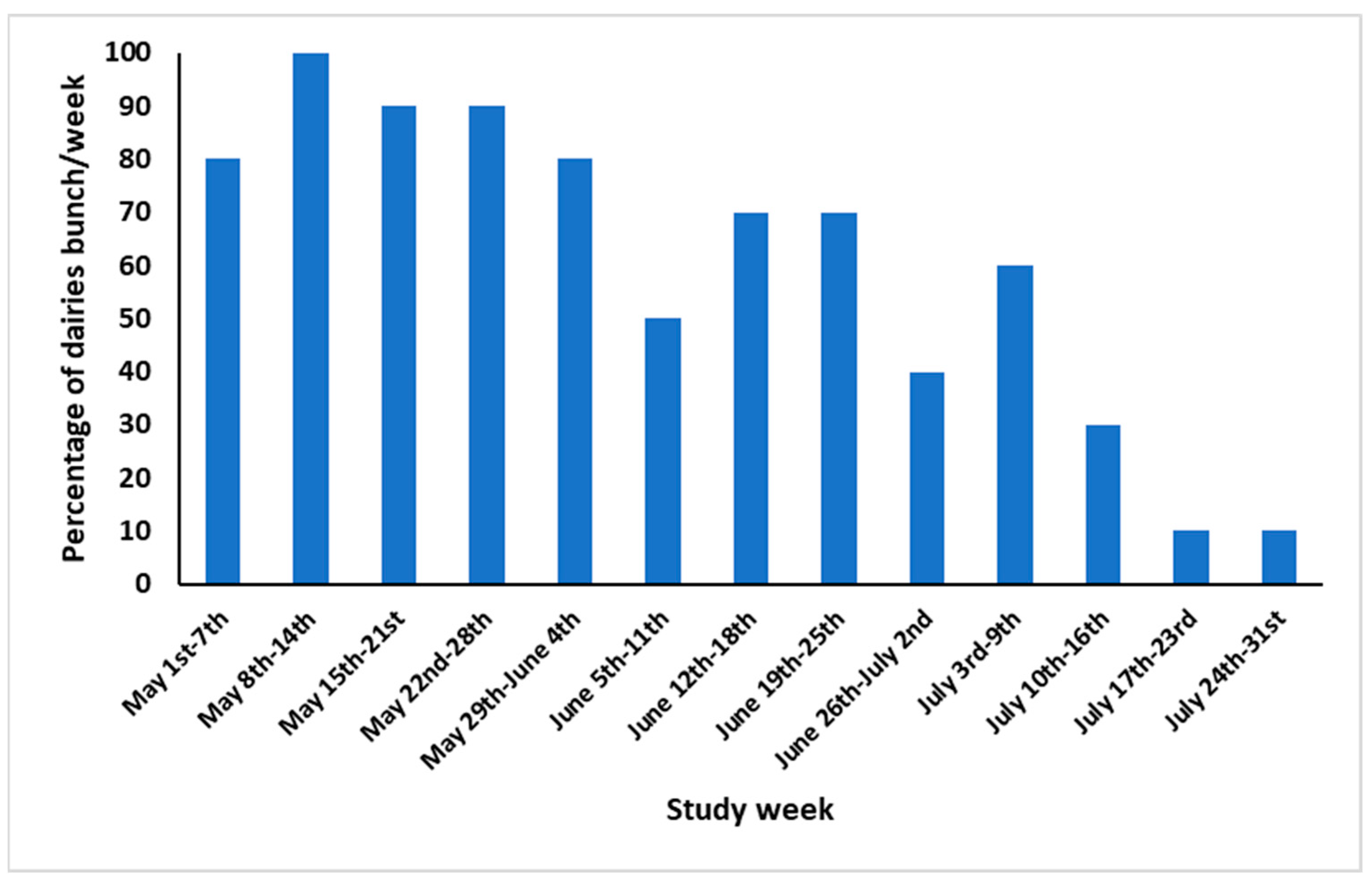
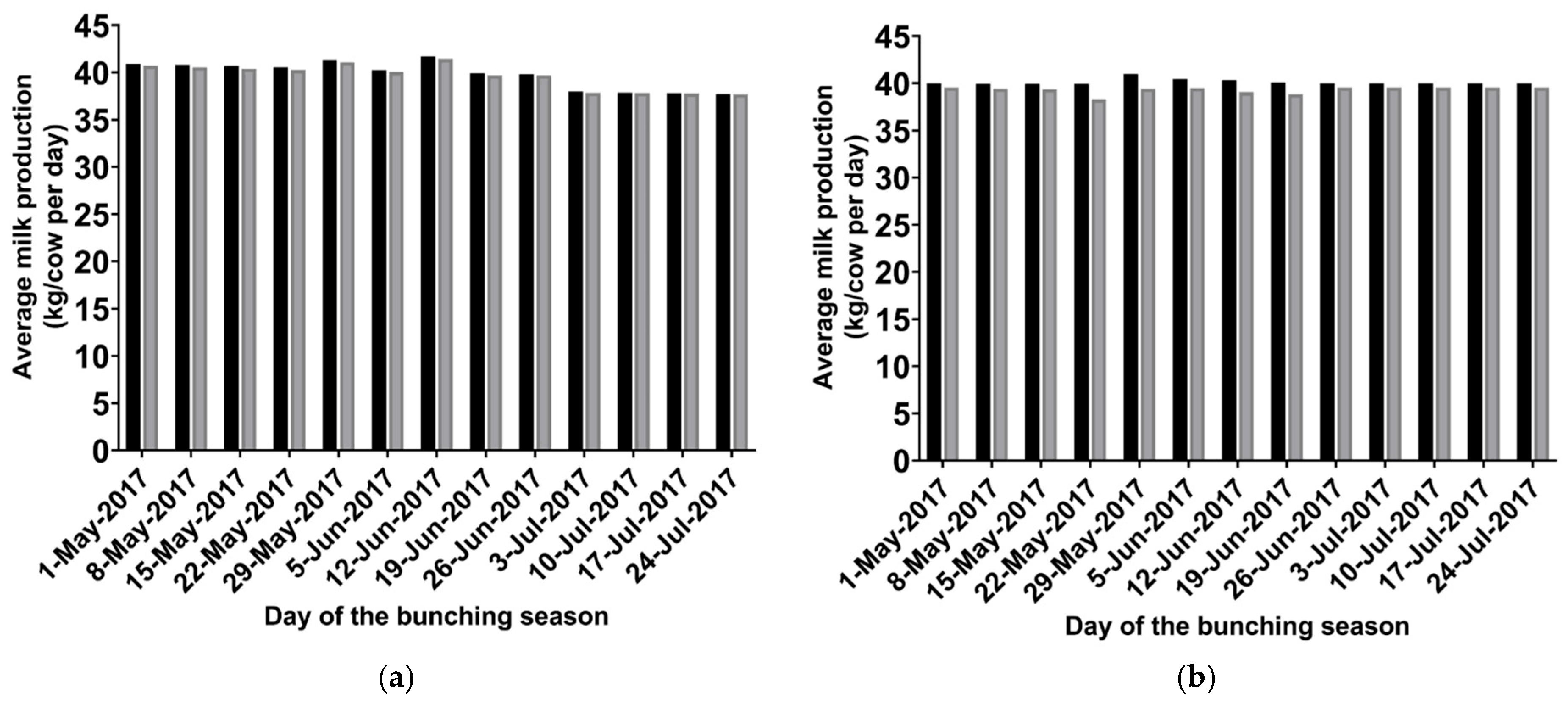
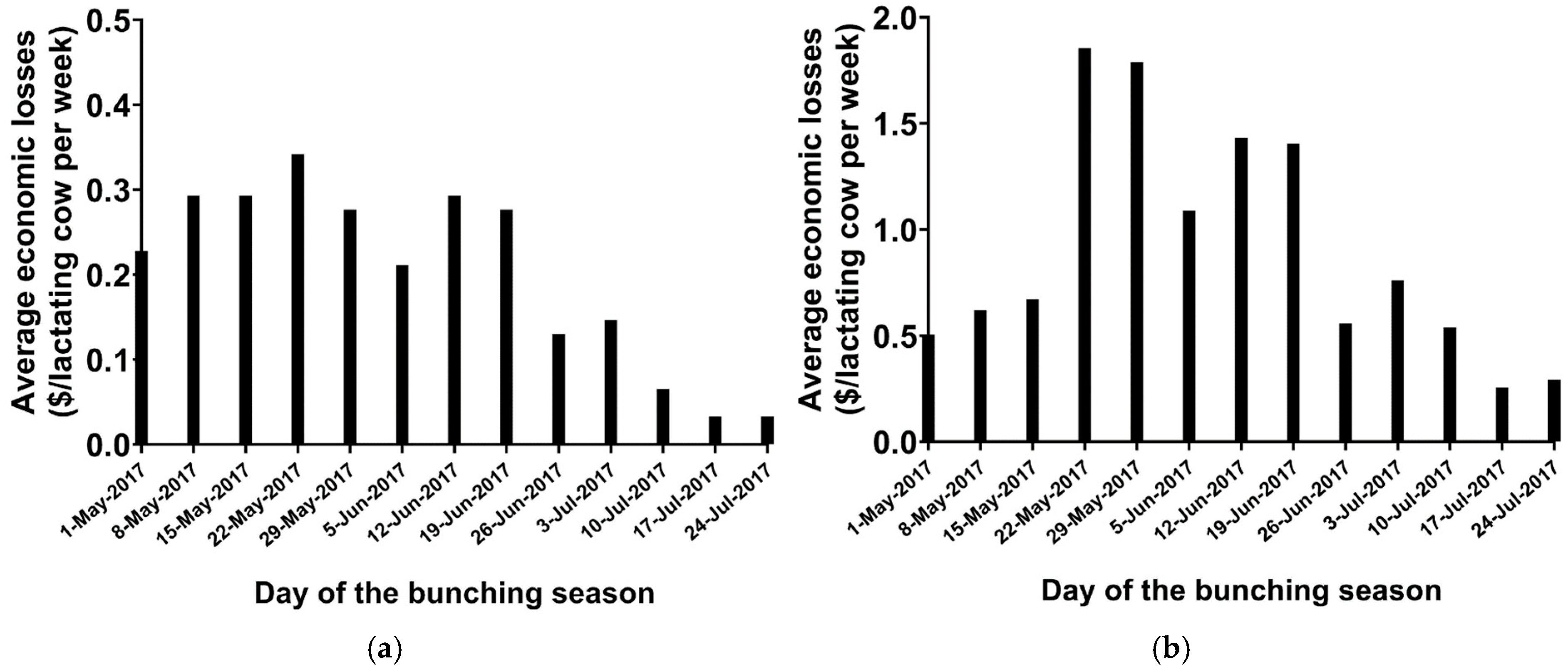

| Variable | Level | Estimate | Standard Error | p-Value | 95% CI | |
|---|---|---|---|---|---|---|
| Lower Limit | Upper Limit | |||||
| Bunching | No | Reference | ||||
| Yes | −0.45 | 0.104 | <0.01 | −0.65 | −0.24 | |
| Parity | Lactation 1 | Reference | ||||
| Lactation 2 | 5.07 | 0.400 | <0.01 | 4.28 | 5.85 | |
| Lactation ≥ 3 | 7.25 | 0.412 | <0.01 | 6.45 | 8.06 | |
| Month | July | Reference | ||||
| May | 1.09 | 0.156 | <0.01 | 0.79 | 1.40 | |
| June | 1.72 | 0.129 | <0.01 | 1.48 | 1.98 | |
| THI | <72 | Reference | ||||
| 72–78 | 0.92 | 0.141 | <0.01 | 0.64 | 1.19 | |
| >78–89 | −0.69 | 0.086 | <0.01 | −0.86 | −0.52 | |
| >89–98 | −4.70 | 0.148 | <0.01 | −4.99 | −4.41 | |
| DIM-Pre-peak | 17.33 | 0.966 | <0.01 | 15.44 | 19.23 | |
| DIM-Post-peak | −12.76 | 0.422 | <0.01 | −13.59 | −11.93 | |
| DIM-Pre-peak square | 17.25 | 1.910 | <0.01 | 13.51 | 20.99 | |
| DIM-Post-peak square | 7.60 | 0.404 | <0.01 | 6.81 | 8.40 | |
| Intercept | 40.56 | 1.500 | <0.01 | 37.62 | 43.50 | |
| Variable | Level | Estimate | Standard Error | p-Value | 95% CI | |
|---|---|---|---|---|---|---|
| Lower Limit | Upper Limit | |||||
| Stable Fly Activity | Stable flies/cow leg | −0.60 | 0.075 | <0.01 | −0.75 | −0.45 |
| Parity | Lactation 1 | Reference | ||||
| Lactation 2 | 6.32 | 0.547 | <0.01 | 5.25 | 7.39 | |
| Lactation ≥ 3 | 7.70 | 0.573 | <0.01 | 6.57 | 8.82 | |
| Month | July | Reference | ||||
| May | 3.12 | 0.188 | <0.01 | 2.75 | 3.49 | |
| June | 2.50 | 0.160 | <0.01 | 2.18 | 2.81 | |
| THI | <72 | Reference | ||||
| 72–78 | 1.66 | 0.174 | <0.01 | 1.32 | 2.01 | |
| >78–89 | −0.80 | 0.113 | <0.01 | 0.58 | 1.02 | |
| >89–98 | −3.38 | 0.186 | <0.01 | −3.74 | −3.01 | |
| DIM-Pre-peak | 28.20 | 1.149 | <0.01 | 25.95 | 30.45 | |
| DIM-Post-peak | −9.55 | 0.440 | <0.01 | −10.42 | −8.69 | |
| DIM-Pre-peak square | 27.38 | 2.072 | <0.01 | 23.32 | 31.44 | |
| DIM-Post-peak square | 5.89 | 0.395 | <0.01 | 5.12 | 6.67 | |
| Intercept | 36.59 | 2.196 | <0.01 | 32.29 | 40.90 | |
| Variable | Distribution | Parameters |
|---|---|---|
| Temperature (°F) | Normal | Average, std = Figure 1 |
| Relative humidity | Normal | Average, std = Figure 1 |
| Percentage of pens that bunch (average per week) | Normal | Average, std = Figure 2 |
| Number of flies (mean leg count per cow) | Pert | Min, most likely, max = Figure 3 |
| Milk price (USD/kg) | Normal | Average = 0.35, std = 0.02 |
| Feed price (USD/kg of milk) | Normal | Average = 0.19, std = 0.01 |
Disclaimer/Publisher’s Note: The statements, opinions and data contained in all publications are solely those of the individual author(s) and contributor(s) and not of MDPI and/or the editor(s). MDPI and/or the editor(s) disclaim responsibility for any injury to people or property resulting from any ideas, methods, instructions or products referred to in the content. |
© 2025 by the authors. Licensee MDPI, Basel, Switzerland. This article is an open access article distributed under the terms and conditions of the Creative Commons Attribution (CC BY) license (https://creativecommons.org/licenses/by/4.0/).
Share and Cite
ElAshmawy, W.R.; Ferreira, F.C.; Williams, D.R.; Gerry, A.C.; Aly, S.S. Daily Milk Losses Associated with Dairy Cow Bunching, Cattle’s Protective Behavior Against Stable Flies (Stomoxys calcitrans) in California. Vet. Sci. 2025, 12, 1035. https://doi.org/10.3390/vetsci12111035
ElAshmawy WR, Ferreira FC, Williams DR, Gerry AC, Aly SS. Daily Milk Losses Associated with Dairy Cow Bunching, Cattle’s Protective Behavior Against Stable Flies (Stomoxys calcitrans) in California. Veterinary Sciences. 2025; 12(11):1035. https://doi.org/10.3390/vetsci12111035
Chicago/Turabian StyleElAshmawy, Wagdy R., Fernanda C. Ferreira, Deniece R. Williams, Alec C. Gerry, and Sharif S. Aly. 2025. "Daily Milk Losses Associated with Dairy Cow Bunching, Cattle’s Protective Behavior Against Stable Flies (Stomoxys calcitrans) in California" Veterinary Sciences 12, no. 11: 1035. https://doi.org/10.3390/vetsci12111035
APA StyleElAshmawy, W. R., Ferreira, F. C., Williams, D. R., Gerry, A. C., & Aly, S. S. (2025). Daily Milk Losses Associated with Dairy Cow Bunching, Cattle’s Protective Behavior Against Stable Flies (Stomoxys calcitrans) in California. Veterinary Sciences, 12(11), 1035. https://doi.org/10.3390/vetsci12111035








